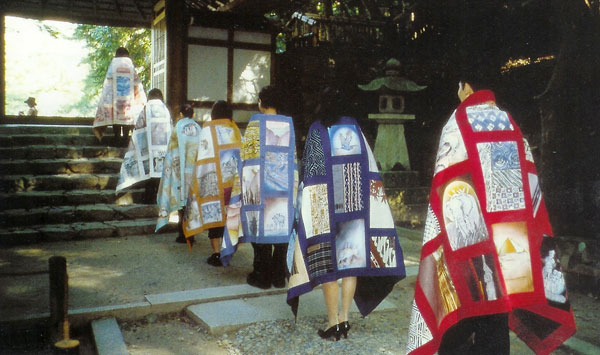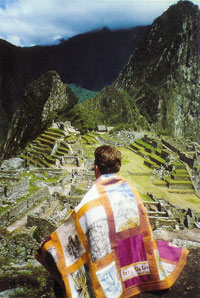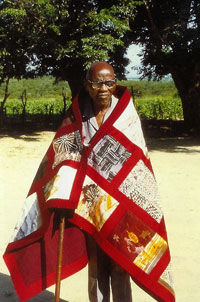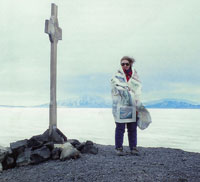 |
 |
 |
 |
 |
 |
 |
 |
 |
 |
 |
 |
 |


Kiranada (Betsy) Sterling Benjamin Kesa for the Millennium
worn in procession to
the entrance of Honen-in-Temple, Kyoto, February, 2000.
Rozome Robes for Global Healing by Julie Kornblum Betsy Sterling Benjamin was on seven continents for the turn of the millennium, New Year’s Day, 2000. That is, her seven Kesa for the Millennium were there. The kesa — Buddhist prayer cloths — were worn by an ecumenical roster of participants in ceremonies of healing and peace. The Australian kesa was worn in an interfaith service that greeted the first dawn of the new millennium in Hobart, Tasmania. A scientist at McMurdo Station, Antarctica wrapped the kesa over her parka in meditation at historic Hut Point. In Bubion, Granada, Spain, the European kesa was worn in a quiet meditation on the village threshing ground with a view down the mountains and across the sea to Africa. The ninety-six year old founder of the Zimbabwean Methodist Church wore the African kesa for his New Year’s Day services in Shurugi. The North American kesa was part of a weekend meditation in an Episcopal contemplative retreat house on the grounds of a Benedictine Monastery. An international group hiked to Machu Picchu with the South American kesa in a backpack, and held a ceremony overlooking the ancient temple. In Asia, Benjamin and 29 friends from five continents hiked up Kyoto’s Daimon-ji Mountain for a millennium meditation with the kesa led by a Soto Zen Priest. Kesa history begins with Buddha’s instructions to his disciple, Ananda, to make sacred robes in the pattern of the rice fields, Benjamin explains, “all locked together and supporting each other.” He said to use discarded fabrics in the colors of the land. Monks lived in poverty and humility, owning nothing of value. So they took the fabrics no one else wanted. In Japan special kimonos of deceased parishioners were donated to the temple to be used for patches in kesa. Benjamin had worked with Japanese textile forms such as kimono, obi, standing screens, and scrolls. For years she had wanted the opportunity to research and work with the kesa as an artist. The seven kesa — each a major work in itself — had to be completed by October 1999, to allow time for them to be photographed and shipped to points around the globe. Benjamin enlisted the help of fiber artist and master seamstress Wendy Carrol to assemble them. Diagrams in a Japanese kesa book showed how to measure and sew the blocks and borders. Kesa can have anywhere from three to twenty-five columns of blocks framed by borders. Benjamin’s choice of seven-column kesa was both practical and conceptual. Historically, kesa of three and five columns are worn only inside the temple. Only seven-column kesa are worn when monks go out into the world. These kesa were definitely going out to the world, and seven columns gave Benjamin an optimal size of blocks for making images. The silk dupioni borders represent a dominant color of each continent. Sky blue is for the vast North American sky, a glacial white for Antarctica. Africa has deep red borders, Europe is cool green, and Australia is a warm sandy brown. South America is an iridescent gold and violet. And Asia is indigo. Benjamin used primarily wax-resist to create the images on silk. As she started each new kesa, She cleaned the studio and created a new palette of dyes. The rozome images are embellished with gold powder, machine embroidery, and appliqué. With great reverence for the subject — the Earth — and the object — the kesa — Benjamin lovingly created images that resonate a strong sense of the land. Japanese textile designs, the Saguaro cacti of Arizona, the cylindrical windmills of Spain, and the African Elephant are some of the natural and human-made features characteristic of each continent. Standing among the seven kesa evokes a sense of interconnectedness. One can gaze from Ayer’s Rock in Australia to Stonehenge on the European kesa, and from Antarctica, where Adelie penguins play on the ice, to the Pyramids of Giza on the African Kesa. Benjamin’s extensive travel and environmental concern, her long career in batik and research in Japanese textiles, and her deep sense of spirit all came together in February of 1999, as she began working on the seven kesa. Her greatest love as a fiber artist is “wax on cloth”. She uses rozome in most of her exhibition work. Rozome literally means wax (ro) and dyeing (zome). She did batik for fifteen years before going to Japan in 1981 to study, and remained in Japan to research, exhibit and teach for almost 20 years. Her book, The World of Rozome: Wax Resist Textiles of Japan (1996), the only book on Rozome in English, was reissued in 2002 in soft cover. By February 2000, the kesa returned to Japan for the first of six exhibitions. A thousand people came in one week to see the show in Kyoto at Honen-in Temple. Buddhist priests of different sects came, alone at first, and then returning the next day with their brothers. Benjamin saw their pious faces turn to slight smiles, and then grins. Many approached her later and thanked her for doing the project, for making contemporary kesa — while honoring their ancient spiritual practice. Benjamin initiated the project out of a personal desire to promote spiritual unity in the face of global discord. As memories of the Y2K scare faded, the shock of September 11, 2001 moved many — including the least religious — to prayer. In light of the events of the past five years, the kesa, with their message of transformation and healing, remain poignantly relevant. ©Julie Kornblum |
South African Kesa Worn at Machu Pichu, January 1, 2000. Silk fabric rozome wax resist, appliqué, embroidery, stenciled gold powder, 42" x 78", 1999.
African Kesa Worn by Rev. E.T.J. Namapare in Zimbabwe, January 1, 2000.
Antarctican Kesa Worn by Dr. Roberta Score at Hut Point, January 1, 2000. Silk fabric, rozome wax resist, appliqué. embroidery, stenciled gold powder, 42" x 78", 1999. |
||
Julie Kornblum is a fiber artist and freelance grantwriter who lives and works in Woodland Hills, California. Postcards of the kesa are available from Betsy Sterling Benjamin for $10.00 for a set of eight. This article first appeared in the Surface Design Journal, Fall 2002. Text copyrighted by Julie Kornblum and may not be used without permission from the author. http://home.earthlink.net/~jkdesigns Photographs and images copyrighted by Betsy Sterling Benjamin and may not be used without permission from the artist. |


